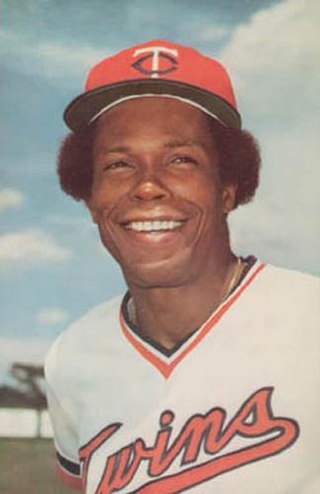Baseball statistics play an important role in evaluating the progress of a player or team.

In baseball statistics, on-base percentage (OBP) measures how frequently a batter reaches base. An official Major League Baseball (MLB) statistic since 1984, it is sometimes referred to as on-base average (OBA), as it is rarely presented as a true percentage.

In baseball statistics, slugging percentage (SLG) is a measure of the batting productivity of a hitter. It is calculated as total bases divided by at-bats, through the following formula, where AB is the number of at-bats for a given player, and 1B, 2B, 3B, and HR are the number of singles, doubles, triples, and home runs, respectively:
Runs created (RC) is a baseball statistic invented by Bill James to estimate the number of runs a hitter contributes to their team.
Speed Score, often simply abbreviated to Spd, is a statistic used in Sabermetric studies to evaluate a baseball player's speed. It was invented by Bill James, and first appeared in the 1987 edition of the Bill James Baseball Abstract.

In baseball statistics, batting average on balls in play is a measurement of how often batted balls result in hits, excluding home runs. It can be expressed as, "when you hit the ball and it’s not a home run, what’s your batting average?" The statistic is typically used to evaluate individual batters and individual pitchers.
The 1999 Chicago White Sox season was the White Sox's 100th season. They finished with a record of 75–86, good enough for 2nd place in the American League Central, 21.5 games behind the 1st place Cleveland Indians.
The 1946 Chicago White Sox season was the White Sox's 46th season in the major leagues, and their 47th season overall. They finished with a record of 74–80, good enough for 5th place in the American League, 30 games behind the first place Boston Red Sox.
The 1945 Chicago White Sox season was the White Sox's 45th season in the major leagues, and their 46th season overall. They finished with a record of 71–78, good enough for 6th place in the American League, 15 games behind the 1st place Detroit Tigers.
The 1944 Chicago White Sox season was the White Sox's 44th season in the major leagues, and their 45th season overall. They finished with a record of 71–83, good enough for 7th place in the American League, 18 games behind the first place St. Louis Browns.
The 1942 Chicago White Sox season was the White Sox's 43rd season. They finished with a record of 66–82, good enough for 6th place in the American League, 34 games behind the 1st place New York Yankees.
The 1939 Chicago White Sox season was the team's 39th season in major league baseball, and its 40th season overall. They finished with a record of 86–69, good enough for 4th place in the American League, 22 games behind the first place New York Yankees.
The 1938 Chicago White Sox season was the White Sox's 38th season in the major leagues and their 39th season overall. They finished with a record of 65–83, good enough for 5th place in the American League, 32 games behind the first place New York Yankees.
The 1937 Chicago White Sox season was the White Sox's 37th season in the major leagues, and their 38th season overall. They finished with a record of 86–68, good enough for 3rd place in the American League, 16 games behind the first place New York Yankees.
The Houston Astros' 1994 season was a season in American baseball. It involved the Houston Astros attempting to win the inaugural season of the National League Central division; they finished in second place. First baseman Jeff Bagwell was a unanimous selection for the National League Most Valuable Player Award. Despite nearly the last two months of the being cancelled due to the 1994–95 strike, Bagwell set a then-club record for home runs with 39 and a club record for batting average (.368) and slugging percentage (.750).
The 2002 Cleveland Indians season was the 102nd season for the franchise. The 2002 Major League Baseball season began on March 31, 2002.The team finished third in the American League Central Division behind the Minnesota Twins and the Chicago White Sox.
The 1901 Cleveland Blues season was a season in American baseball. It was the franchise's first in the majors, being one of the original franchises of the American League. Called the "Blues" or "Bluebirds", the team finished seventh out of eight teams.
In baseball, wOBA is a statistic, based on linear weights, designed to measure a player's overall offensive contributions per plate appearance. It is formed from taking the observed run values of various offensive events, dividing by a player's plate appearances, and scaling the result to be on the same scale as on-base percentage. Unlike statistics like OPS, wOBA attempts to assign the proper value for each type of hitting event. It was created by Tom Tango and his coauthors for The Book: Playing the Percentages in Baseball.
Wins Above Replacement or Wins Above Replacement Player, commonly abbreviated to WAR or WARP, is a non-standardized sabermetric baseball statistic developed to sum up "a player's total contributions to his team". A player's WAR value is claimed to be the number of additional wins his team has achieved above the number of expected team wins if that player were substituted with a replacement-level player: a player who may be added to the team for minimal cost and effort.







